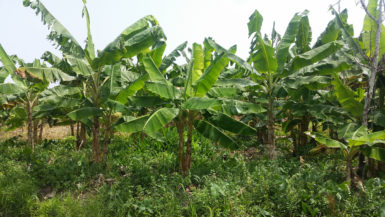Efforts by the Ministry of Agriculture to educate farmers on how to combat the Black Sigatoka disease is having a positive impact with many now able to contain the fungus resulting in bountiful plantain harvests which has caused a drop in the price of the crop on the local market.
This is according to the Ministry, which, in a statement yesterday, said that the impacts of the interventions are being felt with many plantain farmers being able to have better control of the Black Sigatoka disease. Currently, many farmers across the country are harvesting plantains. The abundance of the crop on the local market has caused the price to fall from $100 per pound to $60 per pound in some areas, the statement said.
It pointed out that the National Agricultural Research and Exten-sion Institute (NAREI) is intensifying its education and awareness efforts to better inform plantain farmers about the Black Sigatoka disease.

The statement highlighted the case of Nandkishore Sanichara, a plantain farmer operating in Pomeroon, Region Two, who is currently harvesting between 30,000 to 40,000 pounds of plantain weekly. He has about 40 acres of land under cultivation. He said that farmers have been battling the Black Sigatoka disease for years and due to educational efforts by extension officers, farmers know how to identify and treat the fungus.
He related that farmers were advised on how to select and treat planting materials, steps taken during land preparation, and the continuous care for the suckers, the statement said.
“We know how to control the Black Sigatoka but during the dry period the disease was getting a little out of control…I follow the advice NAREI give…I keep watching the leaves, chop off and burn which ever leaves getting brown and I spraying the chemicals so my crops good…I harvesting nice bunch plantains,” the farmer was quoted as saying.
Another farmer, Reemal Gangadin, who has been planting plantain for over 10 years at his farm at Hague, West Coast Demerara, said that constant monitoring is critical to winning the battle. According to the ministry, he has been zealously following directions provided by NAREI and has been reaping the results. “Since I monitoring and spraying the chemicals things have improved…I benefited from assistance provided by CHF and PROPEL…NAREI staff come around often too,” Gangadin was quoted as saying.
The statement noted that NAREI has created demonstration plots in several farming communities which were significantly affected by the disease. The intention is to offer farmers’ firsthand knowledge about good farming practices crucial for healthy plantain production. Plots were located at Clonbrook and Hand-en-Veldt in Region Four; Leguan and Wakenaam in Region Three; and Golden Fleece and Queenstown in Region Two.
Gangadin believes that the demonstration plot created in Hague will benefit the farmers greatly. “I think it’s a good idea…farmers can go and see what to do and then take it back to their farms,” he was quoted as saying.
The ministry said that the demonstration plots will complement earlier measures taken by NAREI. These include workshops and field training for extension officers and farmers, and supply of chemicals. The Institute’s efforts were supported by several partners including the Food and Agriculture Organisation, the Canadian Hunger Foundation (CHF), PROPEL, and the Caribbean Agricultural Research & Development Institute.
The statement said that NAREI is encouraging farmers to make use of the demonstration plots as it is of the view that there is a nexus between proper farming practices and a good yield.
For several years, the Black Sigatoka disease has been affecting local plantain production. The disease strives in the heat and humidity of the tropics. While it cannot be eliminated, it could be controlled with proper farming practices, the statement noted.





